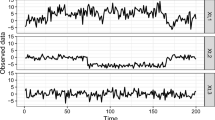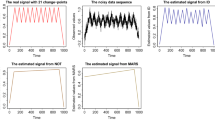Abstract
Change point detection algorithms have numerous applications in areas of medical condition monitoring, fault detection in industrial processes, human activity analysis, climate change detection, and speech recognition. We consider the problem of change point detection on compositional multivariate data (each sample is a probability mass function), which is a practically important sub-class of general multivariate data. While the problem of change-point detection is well studied in univariate setting, and there are few viable implementations for a general multivariate data, the existing methods do not perform well on compositional data. In this paper, we propose a parametric approach for change point detection in compositional data. Moreover, using simple transformations on data, we extend our approach to handle any general multivariate data. Experimentally, we show that our method performs significantly better on compositional data and is competitive on general data compared to the available state of the art implementations.






Similar content being viewed by others
References
Chen J, Gupta AK (2011) Parametric statistical change point analysis: with applications to genetics, medicine, and finance. Springer Science & Business Media
Wu J, Chen Y, Zhou S, Li X (2016) Online steady-state detection for process control using multiple change-point models and particle filters. IEEE Trans Autom Sci Eng 13(2):688–700
Wu J, Xu H, Zhang C, Yuan Y (2019) A sequential bayesian partitioning approach for online steady-state detection of multivariate systems. In: IEEE Transactions on automation science and engineering. https://doi.org/10.1109/TASE.2019.2900482
Basseville M, Nikiforov IV (1993) Detection of abrupt changes: theory and application. Prentice Hall , Englewood Cliffs
Grunwald GK, Raftery AE, Guttorp P (1993) Time series of continuous proportions. Journal of the Royal Statistical Society. Series B (Methodological), 103–116
Pawlowsky-Glahn V, Buccianti A (2011) Compositional data analysis: Theory and Applications. John Wiley & Sons, New York
Aitchison J (1982) The statistical analysis of compositional data. J R Stat Soc Ser B Methodol 44(2):139–160. Wiley Online Library
Snyder RD, Ord JK, Koehler AB, McLaren KR, Beaumont AN (2017) Forecasting compositional time series: a state space approach. Int J Forecast 33(2):502–512
Killick R, Fearnhead P, Eckley IA (2012) Optimal detection of changepoints with a linear computational cost. J Am Stat Assoc 107(500):1590–1598
Montanez GD, Amizadeh S, Laptev N (2015) Inertial hidden markov models: Modeling change in multivariate time series. In: AAAI, pp 1819–1825
Wang T, Samworth RJ (2018) High dimensional change point estimation via sparse projection. J R Stat Soc Series B Stat Methodol 80(1):57–83
Chen H, Zhang N, et al. (2015) Graph-based change-point detection. Ann Stat 43(1):139–176
Kawahara Y, Yairi T, Machida K (2007) Change-point detection in time-series data based on subspace identification. In: 7th IEEE International conference on data mining (ICDM), pp 559–564
Berkes I, Gabrys R, Horváth L, Kokoszka P (2009) Detecting changes in the mean of functional observations. J R Stat Soc Series B Stat Methodol 71(5):927–946
Aminikhanghahi S, Cook DJ (2017) A survey of methods for time series change point detection. Knowl Inf Syst 51(2):339–367
Truong C, Oudre L, Vayatis N (2020) Selective review of offline change point detection methods. Signal Processing, 167, 107–299
Vert J-P, Bleakley K (2010) Fast detection of multiple change-points shared by many signals using group LARS
Liu S, Yamada M, Collier N, Sugiyama M (2013) Change-point detection in time-series data by relative density-ratio estimation. Neural Netw 43:72–83
Matteson DS, James NA (2014) A nonparametric approach for multiple change point analysis of multivariate data. J Am Stat Assoc 109(505):334–345
Barry D, Hartigan JA (1993) A bayesian analysis for change point problems. J Am Stat Assoc 88(421):309–319
Adams RP, MacKay DJ (2007) Bayesian online changepoint detection. arXiv:0710.3742
Hinkley DV (1970) Inference about the change-point in a sequence of random variables. Biometrika 57:1–17
Brodsky E, Darkhovsky BS (2013) Nonparametric methods in change point problems. Springer Science & Business Media, vol 243
Zou C, Yin G, Feng L, Wang Z, et al. (2014) Nonparametric maximum likelihood approach to multiple change-point problems. Ann Stat 42(3):970–1002
Kawahara Y, Sugiyama M (2009) Change-point detection in time-series data by direct density-ratio estimation. In: Proceedings of the 2009 SIAM international conference on data mining, pp 389–400
Arlot S, Celisse A, Harchaoui Z (2019) A kernel multiple change-point algorithm via model selection. J Mach Learn Res 20(162):1–56
Minka T (2000) Estimating a dirichlet distribution, Technical report, MIT
Erdman C, Emerson JW, et al. (2007) Bcp: an r package for performing a bayesian analysis of change point problems. J Stat Softw 23(3):1–13
James NA, Matteson DS (2013) ecp: An r package for nonparametric multiple change point analysis of multivariate data. arXiv:1309.3295
Cho H (2016) Change-point detection in panel data via double cusum statistic. Electron J Stat 10(2):2000–2038
Ermes M, Pärkkä J, Mäntyjärvi J, Korhonen I (2008) Detection of daily activities and sports with wearable sensors in controlled and uncontrolled conditions. IEEE Trans Inf Technol Biomed 12 (1):20–26
Burg GJJ, van den Williams CKI (2020) An Evaluation of Change Point Detection Algorithms. arXiv:2003.06222
Demšar J (2006) Statistical comparisons of classifiers over multiple data sets. J Mach Learn Res 7(1):1–30
Holm S (1979) A simple sequentially rejective multiple test procedure. Scandinavian Journal of Statistics 65–70
Author information
Authors and Affiliations
Corresponding author
Additional information
Publisher’s note
Springer Nature remains neutral with regard to jurisdictional claims in published maps and institutional affiliations.
Appendix
Appendix
Rights and permissions
About this article
Cite this article
K. J., P., Singh, N., Dayama, P. et al. Change point detection for compositional multivariate data. Appl Intell 52, 1930–1955 (2022). https://doi.org/10.1007/s10489-021-02321-6
Accepted:
Published:
Issue Date:
DOI: https://doi.org/10.1007/s10489-021-02321-6




